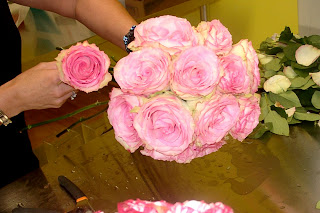






This is the story of all roses that are grown as cut-flowers, but it is also the tale of one very special rose, called “Esperance” or “Esperanza”, the former a French word, the latter Spanish, but both meaning “Hope”. The journey of our rose begins on a farm in Ecuador. Situated at an elevation of almost 11,000 feet, high in the Andes, is the rose plantation of Agricola El Rosario. In the background, surrounded by clouds is the famous volcano of Cotopaxi. Before one single rose is harvested there is a considerable amount of work and forethought that must go into it. The best roses need good soil, with the requisite alimentation, good drainage and precise fertilization. Therefore the land must be prepared properly, with protection against inclement weather, while allowing for high levels of luminosity for the rose plants. The greenhouses in Ecuador were formerly constructed with wood, but analytical studies demonstrated that the amount of timber required prohibited a significant amount of light from reaching the plants. Today the greenhouse structures are engineered and prefabricated from steel to provide sufficient strength to withstand gale force winds and hail storms, as well as a minimally impeding the amount of light reaching each plant. In fact, as well as the design of the greenhouse, technology predominates in every phase of growing a rose, from plant spacing, irrigation, computerized fertilization. A new rose is planted out in one of two ways, either by planting “mini-plants” or more commonly done, by grafting the “eyes” of the desired variety onto rootstock. A mini-plant is a young plant that has been growing for 3-6 months, and come mostly from the breeders in Europe. The “budding eyes” are the little tumescent swellings you will frequently see where a leaf joins the stem. Because the new hybrid varieties are quite delicate and do not form strong roots, they are grafted onto roses with known strength and performance. These roses are called rootstock, and the most frequently used variety today is R. “Natal Briar”, a few on R. "Manetti" and occasionally R. canina. In this series of images are Esperanza roses that have been grafted on to rootstock. You will see here and there a few stems that are bent onto the ground. These are the stems of the rootstock, and provide the necessary photo-synthesis for the new variety to develop. This technique is called “bending” and was developed in Japan. As you can see most of the plants have developed, thrusting strong “basal” stems upwards. It is only the plants that are slow in developing that still have the rootstock leaves attached. Another shot of plants of about nine months, showing roses being sprayed for potential diseases, especially fungii. Here you can see the plants have developed considerably and have produced two or even three basal stems. A good, conscientious grower will now spend up to a year developing the structure of the plant. The grower will be sacrificing potential production, and revenues, in order to create a plant that will give a consistent yield of high quality roses in the future. The object is to create an urn shape featuring 4 or 5 strong canes. All roses are cut and processed by hand, which is incredibly labor intensive. This farm, called “Agricola El Rosario”, comprises about ten hectares, or 24 acres. There are approximately 650,000 plants producing on average about 20,000 stems per day, which is no small feat when you think that each flower, as delicate as it is, has to be cut, hydrated, processed and bunched.
Renato Teran, owner of “Agricola El Rosario” inspecting the first flush of a new variety.
Mayesh Wholesale is proud to be working with farms such as Agricola El Rosario, Producnorte and Evergreen. These rose plantations recognize not only that best farming practices necessitate good stewardship of the precious resources of the environment, they also must shepherd their most important asset, their employees. The workforce is predominantly female, of indigenous origin, and mostly descended from the Incas. For hundreds of years the Incas have been ostracized from Ecuadorian society, living separately, almost like the “Untouchables” of India. Within their society, the women have further been living in bondage bowing to the dictates of their macho traditions. Because his workforce largely comprises of young women, Renato Teran provides not only three square meals per day, doctor consultations three times a week, but also daycare for the children of the employees. Clearly this is not entirely altruistic, as these measures ensure a ready, willing and able workforce, but it does show an understanding of life, and that everyone needs to be nurtured in order to have a chance to realize their dreams and aspirations. It gives the children to grow under proper care, with proper nutrition, and it gives the women an opportunity to earn a living, knowing their children are safe, and try to escape from bondage.
“There is hope. Si ay esperanza!”
Part Two of "2010: A ROSE ODYSSEY" will be publiushed next Monday 23rd August
Acknowledgments
Many thanks to Renato Teran, and the entire team of Agricola El Rosario located at the Hacienda Ortuño.
"Esperanza" is a classic pink rose bred by De Ruiters
No comments:
Post a Comment